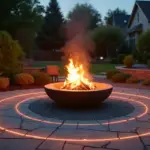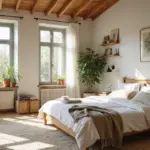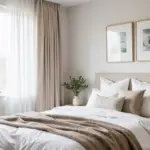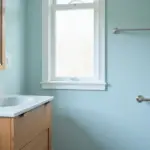When my kitchen cabinets started feeling outdated last year, I faced the classic dilemma: full renovation or strategic refresh? After researching countless solutions, I discovered that thoughtful cabinet makeovers can completely transform a kitchen’s energy without demolition chaos.
Kitchen cabinets set the entire tone of your space. When they feel tired or chaotic, cooking becomes less joyful. But here’s the truth many designers won’t tell you: the most impactful kitchen cabinet makeover often comes from subtle, intentional changes rather than complete replacements.
1. The Transformative Power of Paint
The silence of a freshly painted cabinet speaks volumes. Beyond just color, paint transforms the energy of your entire kitchen. When selecting paint for your kitchen cabinet makeover, consider how light interacts with the space throughout the day. Morning sunlight might make a deep navy feel energizing, while evening lamplight could transform it into a meditative sanctuary.

The preparation process matters more than the actual painting. Before your brush touches wood, create a clean canvas through thorough degreasing and light sanding. This meditation-like preparation ensures the paint adheres properly and creates a finish that withstands daily use. For kitchens specifically, alkyd or acrylic enamel paints offer the durability needed to withstand cooking steam, occasional splashes, and frequent touching.
The magic of this technique lies in its subtle texture of the finished surface—how it catches light differently as you move through the space.
2. Refacing: The Art of Renewal Without Replacement
Refacing creates transformation through mindful preservation. When your cabinet boxes remain structurally sound but their faces no longer serve your aesthetic, refacing offers the perfect middle path—preserving what works while renewing what doesn’t.

This approach honors both sustainability and practicality. By keeping the cabinet boxes (which represent about 70% of material in traditional cabinets), you significantly reduce waste while focusing your investment on the visible surfaces that make the greatest impact. The process involves applying new veneer to exposed cabinet surfaces and replacing doors and drawer fronts, creating a harmonious visual effect that rivals full replacement but with less disruption to your daily life.
Beyond the practical benefits, refacing creates a seamless transition between old and new—honoring the history of your space while embracing fresh energy.
3. The Door Transformation Technique
Sometimes the most powerful change comes from focusing on a single element. Cabinet doors occupy the largest visual space in your kitchen, making them the natural focal point for a kitchen cabinet makeover. By replacing just the doors while maintaining the existing framework, you create dramatic transformation with minimal waste.

The selection process requires thoughtful consideration of both style and proportion. Modern kitchens often benefit from clean-lined slab doors that create visual calm, while traditional spaces might call for raised panels that add depth and dimension. The material choice further influences the energy—wood brings natural warmth, while painted MDF offers crisp uniformity. Whatever style you choose, precise measurements are essential for creating harmony between the new doors and existing cabinet frames.
The interplay between cabinet doors and the surrounding space creates a rhythm that influences how we move through the kitchen.
4. Hardware as Mindful Jewelry
Cabinet hardware functions as more than mere utility—it’s the thoughtful detail that completes your kitchen’s composition. Like carefully chosen jewelry, new knobs and pulls can transform basic cabinets into an expression of personal style with minimal effort and investment.

When selecting hardware, consider both the physical interaction and visual harmony. The hardware you touch dozens of times daily should feel comfortable in your hand while complementing your cabinet style. Modern kitchens often benefit from sleek, minimalist hardware with clean lines, while traditional spaces might call for more detailed pieces that add character. The finish matters as much as the form—brushed nickel offers subtle sophistication, while matte black creates dramatic contrast against lighter cabinets.
“The hardware is where your hands meet your kitchen daily. Choose pieces that feel as good as they look.” – Kai Nakamura
Like the perfectly placed stone in a zen garden, thoughtfully chosen hardware creates focal points that guide the eye through your kitchen space.
5. Illuminating the Work Surface
Light transforms how we experience space. Under-cabinet lighting creates both practical function and subtle ambiance, illuminating work surfaces while adding dimension to your kitchen cabinet makeover. This thoughtful addition highlights the texture of your backsplash while eliminating shadows that can make cooking feel more challenging.

The type of lighting you choose significantly impacts both function and feeling. LED strip lights provide even, energy-efficient illumination with minimal profile, while puck lights create pools of focused light that add drama and dimension. The color temperature matters deeply—warm light (2700K-3000K) creates intimacy and coziness, while cooler light (4000K-5000K) enhances visibility and creates alertness. For ultimate flexibility, consider dimmable options that adapt to different needs throughout the day.
- Install lights approximately 1/2 inch from the front edge of cabinets for optimal countertop illumination
- Consider aluminum channels with diffusers for LED strips to create a more professional, finished look
- Use warm white lighting in areas where you gather and cool white where precision tasks happen
The thoughtful interplay between light and shadow creates depth that transforms flat surfaces into dynamic spaces.
6. Inner Cabinet Illumination
The unexpected delight of interior cabinet lighting creates both function and joy. When you open a cabinet to find the contents gently illuminated, the experience transforms from searching to discovering. This subtle addition to your kitchen cabinet makeover particularly enhances glass-front cabinets or open shelving, creating depth and visual interest even when doors remain closed.

Installation requires minimal effort yet yields significant impact. Most LED strip lights feature adhesive backing for simple application along cabinet tops or sides. For the most elegant effect, position lights to eliminate harsh shadows and choose a color temperature that enhances rather than distorts the natural colors of your dishes and glassware. Motion-activated options offer both convenience and energy efficiency, illuminating only when cabinets are open.
The contrast between the outer kitchen and the illuminated interior creates a moment of discovery each time you open a cabinet door.
7. The Open Shelving Transformation
Open shelving creates breathing space in kitchens that feel confined by too many cabinet doors. By removing select upper cabinet doors—or replacing entire cabinets with floating shelves—you create visual expansion that makes even small kitchens feel more spacious and intentional.

This approach requires thoughtful curation of what remains visible. The items you display become part of your kitchen’s visual composition, so choose pieces that bring both function and beauty. Group items by color or function to create visual calm, and leave negative space between groupings to prevent visual overwhelm. Consider the practical aspect too—items used daily work best on open shelves, while rarely-used pieces might be better stored behind closed doors.
- Best items for open shelving:
- Everyday dishes in complementary colors
- Frequently used cooking tools with interesting shapes
- Glass storage containers with dry goods
- Cookbooks with attractive spines
- Small plants that thrive in kitchen environments
The rhythm created by alternating open and closed storage creates visual interest while maintaining functionality.
8. Glass-Front Cabinet Elegance
Glass-front cabinets create an elegant bridge between open shelving and traditional closed storage. This thoughtful addition to your kitchen cabinet makeover maintains the visual lightness of open shelves while protecting contents from dust and cooking residue. The result is a display that feels intentional rather than exposed.

Different glass types create distinctly different effects. Clear glass offers maximum visibility and works beautifully when displaying curated collections with visual harmony. Frosted or seeded glass provides a more subtle effect, obscuring individual items while still allowing light to pass through. Textured or patterned glass adds visual interest even when the contents remain simple. The frame style matters equally—thin frames create a modern, minimalist look while thicker frames with detailed molding complement traditional kitchens.
The interplay between transparency and structure creates depth that flat cabinet doors cannot achieve.
9. Crown Molding as Thoughtful Completion
Crown molding creates a mindful transition between cabinets and ceiling, completing your kitchen cabinet makeover with architectural intention. This seemingly small addition transforms ordinary cabinets into furniture-like elements that feel purposeful and refined.

The style of molding you select should harmonize with your cabinet design and overall kitchen aesthetic. Traditional kitchens benefit from more detailed profiles that add visual richness, while contemporary spaces often call for simpler, cleaner lines. The scale matters significantly—taller ceilings can support larger moldings, while smaller profiles work better in spaces with standard-height ceilings. For visual harmony, consider echoing elements from other moldings in your home to create continuity between spaces.
The negative space created where cabinets meet ceiling transforms from awkward void to intentional design element through this thoughtful addition.
10. The Backsplash Connection
The backsplash creates visual connection between your cabinets and countertops, unifying separate elements into a cohesive whole. When planning a kitchen cabinet makeover, consider how this vertical surface can bridge materials and colors to create harmony throughout the space.

Material selection creates different energies within the same space. Sleek glass tile reflects light and creates visual expansion, while natural stone adds organic texture and depth. Ceramic tile offers endless possibilities for color and pattern, allowing you to either complement or contrast with your cabinet color. For maximum impact with minimal investment, focus on the area directly behind the sink and stove—the spaces most visible and functional in daily use.
“The backsplash is where function meets expression—the practical surface that protects your walls becomes the canvas that ties your kitchen’s story together.” – Kai Nakamura
The vertical plane of the backsplash draws the eye upward, creating visual flow that connects countertops to cabinets in a seamless visual journey.
11. Decluttering as Foundation
Before any physical transformation, decluttering creates the essential foundation for a successful kitchen cabinet makeover. This process isn’t merely about creating space—it’s about mindfully evaluating what truly deserves a place in your daily life. By removing what no longer serves you, you create both physical and mental space for what matters.

The decluttering process works best when approached systematically, one cabinet at a time. Empty each cabinet completely, wipe it clean, and then thoughtfully evaluate each item before returning it. Ask yourself: Does this serve my current cooking style? Have I used it in the past year? Does it bring both function and joy? Items that fail these tests can be donated, recycled, or discarded, creating space that allows your remaining possessions to breathe.
- Questions to ask during kitchen decluttering:
- When was the last time I used this?
- Do I have multiple items that serve the same function?
- Would I buy this again today?
- Does this support how I actually cook, not how I imagine cooking?
- Is this worth the space it occupies?
The negative space created through decluttering becomes as important as the objects themselves—creating room for both function and visual calm.
12. Internal Organization Systems
The hidden interior of your cabinets deserves as much thoughtful design as the exterior. Internal organization systems transform chaotic cabinets into functional zones where everything has a designated place, making your kitchen cabinet makeover as practical as it is beautiful.

Different cabinet types benefit from specialized organizers. Deep base cabinets become infinitely more accessible with pull-out shelves that bring back-row items forward. Narrow cabinets transform into efficient pantries with door-mounted racks. Drawers maintain order with adjustable dividers that prevent utensils from becoming tangled. The key is matching the organizer to both the cabinet dimensions and the items being stored, creating systems that work with your natural patterns rather than forcing new habits.
The mindful organization of interior spaces creates harmony that extends beyond aesthetics to how you move through your kitchen daily.
13. The Deep Clean Revelation
Sometimes what appears to be tired cabinetry is simply obscured by years of accumulated grime. A thorough deep cleaning can reveal the true character of your cabinets and provide essential preparation for any kitchen cabinet makeover. This process often uncovers beauty hiding beneath surface dirt and creates a clear assessment of what actually needs changing.

The deep cleaning process requires patience and appropriate products for your specific cabinet material. Wood cabinets respond well to gentle oil soap followed by conditioning with food-grade mineral oil. Painted cabinets typically need degreasing with a solution of warm water and dish soap, while laminate surfaces can handle slightly stronger cleaners. Pay special attention to areas around handles and near the stove where grease accumulates most heavily. For stubborn buildup, a paste of baking soda and water applied with a soft brush can work wonders without damaging finishes.
The ritual of deep cleaning connects you physically to your space, creating awareness of details that might otherwise go unnoticed in your daily routine.
14. Interior Wallpaper Surprise
The unexpected delight of opening a cabinet to discover beautiful wallpaper creates joy in everyday moments. This simple addition to your kitchen cabinet makeover transforms utilitarian storage into spaces that surprise and delight, adding personality without overwhelming the overall kitchen design.

Material selection matters significantly for this application. Vinyl or vinyl-coated wallpapers offer the best durability in kitchen environments where moisture and occasional spills are inevitable. Peel-and-stick options simplify installation and allow for easier future changes. For pattern selection, consider scale carefully—smaller patterns generally work better in confined cabinet interiors than large-scale designs that might feel chaotic in limited space. Geometric patterns create modern energy, while subtle textures add dimension without visual busyness.
The contrast between the exterior and interior creates a moment of discovery each time you open a cabinet door—a small but significant joy in daily kitchen use.
15. Wall Color Harmony
Wall color creates the backdrop against which your kitchen cabinet makeover is viewed. The right shade complements your cabinets and countertops while establishing the overall mood of your kitchen—whether energizing, calming, or somewhere in between.
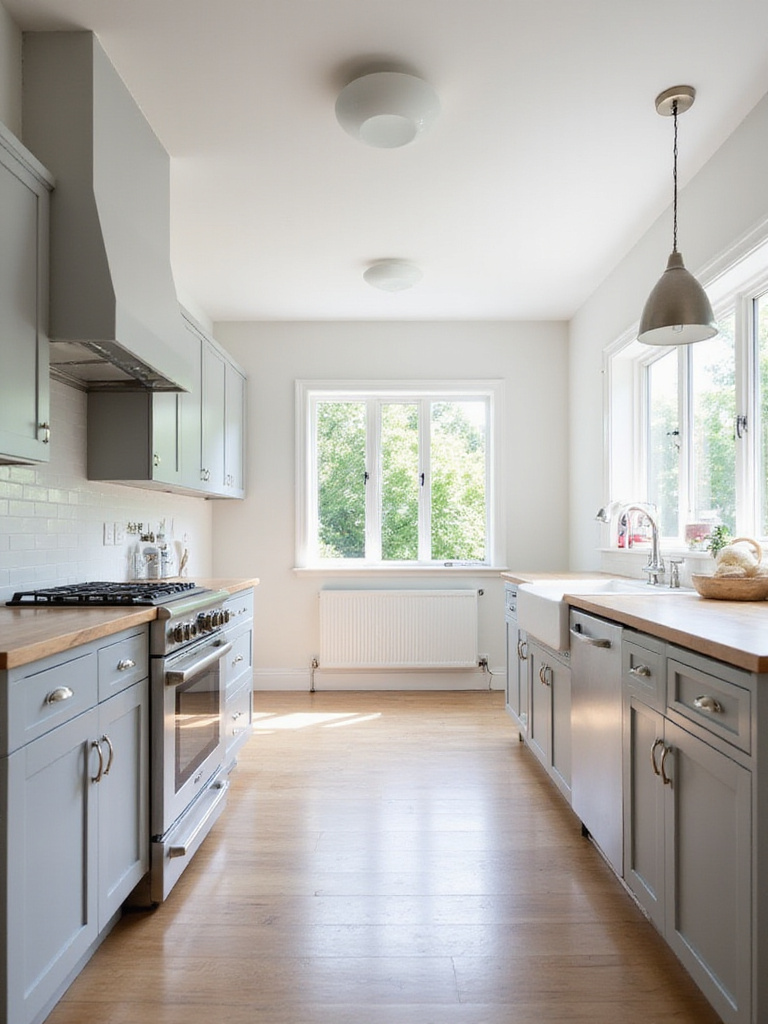
The selection process should consider both practical and aesthetic factors. Light reflectance value (LRV) affects how bright your kitchen feels, with higher values reflecting more light and making spaces feel larger. The undertones in your wall color should harmonize with cabinet and countertop undertones—warm with warm, cool with cool—to create visual coherence. Testing samples in your actual space under different lighting conditions reveals how colors truly behave in your specific environment, often appearing quite different from how they look in a store or online.
The thoughtful transition between cabinet and wall creates either subtle harmony or intentional contrast, both equally valid depending on your design intention.
16. Door Swing Direction Optimization
The direction your cabinet doors open might seem insignificant until you experience the difference thoughtful adjustment makes. Changing door swing direction creates immediate improvement in kitchen flow, removing obstacles and friction from daily movements. This often-overlooked aspect of a kitchen cabinet makeover costs almost nothing yet yields significant functional benefits.

Assessment requires observing how you actually use your kitchen. Notice where doors conflict with walkways, appliances, or other cabinets when open. Identify cabinets that would function better with hinges on the opposite side, particularly those near corners or major appliances like refrigerators. The adjustment itself is relatively simple—removing doors, filling existing hinge holes, drilling new ones, and reattaching hardware—but the impact on daily kitchen use can be profound.
The space between objects—the ma in Japanese design—becomes as important as the objects themselves when optimizing movement through your kitchen.
17. Island Integration Strategy
An island creates both additional storage and a central gathering point that transforms how a kitchen functions. Whether built-in or mobile, this addition to your kitchen cabinet makeover creates workspace that complements your existing cabinets while adding valuable storage and countertop surface.

The form should follow both function and available space. In smaller kitchens, rolling carts offer flexibility to move the island when more floor space is needed. Larger kitchens can accommodate permanent islands with specialized storage for specific needs—deep drawers for pots and pans, vertical dividers for baking sheets, or even refrigerator drawers for beverages. The island’s cabinet style can either match existing cabinetry for visual cohesion or intentionally contrast to create a furniture-like focal point.
The negative space around an island creates natural movement paths that influence how people interact within the kitchen environment.
18. Pantry Integration for Focused Storage
A dedicated pantry cabinet creates intentional separation between food storage and dishware, allowing each to function optimally. This strategic addition to your kitchen cabinet makeover removes food items from regular cabinets, creating more space for dishes and cooking equipment while providing specialized storage optimized for groceries.

Different pantry configurations serve different needs. Pull-out pantries maximize storage in narrow spaces, bringing all contents into full view with a single motion. Cabinet pantries with internal organizers create designated zones for different food categories. Freestanding pantries offer flexibility and additional countertop space for small appliances. The key is matching the pantry style to both your available space and specific storage needs, creating a system that works with your shopping and cooking patterns.
The mindful separation of food storage from other kitchen functions creates clarity that extends beyond physical organization to mental clarity in meal preparation.
19. Door-Mounted Maximization
The often-overlooked interior surface of cabinet doors offers valuable storage potential. Door-mounted organizers transform this unused space into functional storage that keeps frequently used items visible and accessible, adding efficiency to your kitchen cabinet makeover without requiring additional square footage.

Different door locations benefit from specialized organizers. Sink cabinet doors can hold cleaning supplies on adjustable racks. Pantry doors become perfect homes for spice collections or measuring tools. Upper cabinet doors might hold small items like food wrap boxes or pot lids. The key consideration is depth—ensure that door-mounted organizers don’t prevent the door from closing properly or interfere with interior shelves and their contents.
- Best items for door-mounted storage:
- Spice jars in slim racks
- Measuring cups and spoons on hooks
- Cleaning supplies in wire baskets
- Aluminum foil and plastic wrap boxes
- Pot lids in vertical organizers
- Small cutting boards in slim racks
The transformation of previously unused surfaces into functional storage creates efficiency that extends beyond physical space to time saved in daily cooking.
20. Countertop Connection
Countertops create the horizontal plane on which most kitchen work happens, making them essential partners to your cabinet makeover. The material, color, and texture of your countertops significantly impact how your newly refreshed cabinets are perceived, either enhancing or diminishing their visual impact.

Material selection should balance both aesthetic and practical considerations. Quartz offers exceptional durability with minimal maintenance, ideal for busy households. Granite brings natural variation and character but requires periodic sealing. Butcher block adds warmth but needs more regular maintenance. Beyond material, consider edge profile—simple eased edges create modern simplicity, while more detailed ogee or bullnose profiles complement traditional cabinetry. The thickness also impacts perception—thinner profiles (3/4″) create contemporary sleekness, while thicker edges (1 1/4″ or more) add visual weight and presence.
The junction where vertical cabinet surfaces meet horizontal countertops creates a rhythm that influences how the entire kitchen is perceived.
21. Sink and Faucet Harmony
The sink and faucet create a functional focal point that naturally draws attention in any kitchen. Updating these elements alongside your kitchen cabinet makeover creates cohesion while improving the daily experience of cooking and cleaning. This relatively simple change yields significant impact on both aesthetics and functionality.

Style selection should complement your cabinet design while addressing practical needs. Undermount sinks create clean lines that work beautifully with modern cabinetry, while farmhouse sinks make a statement that pairs perfectly with traditional or transitional styles. Faucet selection offers another opportunity for personalization—sleek, single-handle designs complement contemporary kitchens, while bridge faucets with separate hot and cold handles enhance traditional spaces. Finish matters significantly—brushed nickel offers timeless versatility, while matte black creates dramatic contrast against lighter cabinets and countertops.
The sink area functions as both practical workspace and visual anchor, connecting the horizontal plane of countertops with the vertical plane of backsplash in a cohesive composition.
22. Flooring as Foundation
Flooring creates the foundation upon which your entire kitchen stands, making it a crucial consideration for any comprehensive kitchen cabinet makeover. The right flooring complements your cabinets while providing the durability needed in this high-traffic, high-moisture environment.

Material selection should balance visual harmony with practical performance. Porcelain tile offers exceptional durability and moisture resistance with nearly unlimited design options. Luxury vinyl plank provides the look of wood with superior water resistance and comfort underfoot. Engineered hardwood strikes a balance between the warmth of natural wood and improved stability in variable humidity. Color selection is equally important—lighter floors generally make spaces feel larger and more open, while darker floors create drama and ground the space. Consider the visual weight of your cabinets when choosing—lighter cabinets offer more flexibility in flooring color, while darker cabinets often pair best with lighter floors to prevent the space from feeling too heavy.
The thoughtful connection between vertical cabinet surfaces and horizontal flooring creates harmony that unifies the entire kitchen composition.
Creating Your Own Kitchen Cabinet Transformation
The most successful kitchen cabinet makeover reflects your unique needs and aesthetic preferences rather than following generic trends. By combining elements from these 22 ideas, you can create a kitchen that functions beautifully for your specific cooking style while expressing your personal design sensibility.
Start by assessing what truly bothers you about your current kitchen—is it primarily aesthetic, functional, or both? Focus your initial efforts on addressing these pain points, then expand to other enhancements as budget allows. Remember that even small changes—new hardware, interior organization, or under-cabinet lighting—can dramatically improve both the look and function of your kitchen. The goal isn’t perfection but rather creating a space that supports and inspires your daily life, bringing a sense of calm functionality to the heart of your home.

